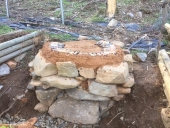Hello.
I am building an outdoor oven for cooking and baking in the garden. I have poured over different designs online and am using the "20$ cob oven" design with some twists.
I dug into the slope and, to my surprise, found red clay underneath 2 feet of topsoil. I am using that red clay for the cob. There was a plenty of boulders laying around for the foundation.
Since I am missing on sand to mix with the clay and straw to make cob, I would like to use some materials that I have at hand.
One is a coal slag used for sandblasting. Here is its chemical composition:
The chemical composition of bottom ash and boiler slag particles is controlled by the source of the coal and not by the type of furnace. Coal ash is composed primarily of silica (SiO2), ferric oxide (Fe2O3), and alumina (Al2O3), with smaller quantities of calcium oxide (CaO), potassium oxide (K2O), sodium oxide (Na2O), magnesium oxide (MgO), titanium oxide (TiO2), phosphorous pentoxide (P2O5), and sulfur trioxide (SO3).
The other one is ferric oxide (Fe2O3) that I collected from a dry bed of a creek using a strong magnet. They look similar, but one is magnetic and the other is not.
So, the stove design calls for use of perlite to cover these empty bottles to create a layer that retains heat underneath the brick floor of the oven chamber. I believe I can substitute perlite with a coal slag. It went through 2400 degrees burning in the burning chamber and is quite inert. I think that in the building of the dome, I can replace sand with ferric oxide. I am not sure if anyone has ever done it before and would like to hear any pro or contra opinions about its use. Could it help in making a better heat shield?
Another idea that I want to try is to embed several powerful neodymium magnets within cob. If the heat will not destroy its magnetic capability, I can attach steel pots and cast iron pans magnetically, without using any hooks.











